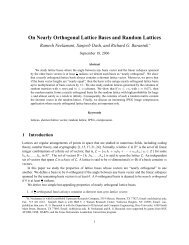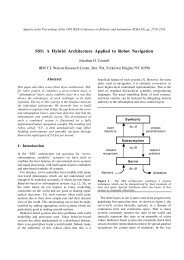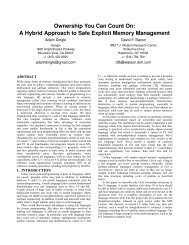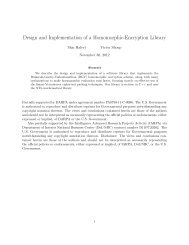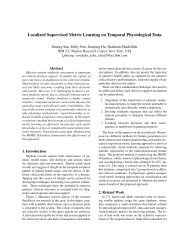SHIP: A Scalable Hierarchical Power Control ... - IEEE Xplore
SHIP: A Scalable Hierarchical Power Control ... - IEEE Xplore
SHIP: A Scalable Hierarchical Power Control ... - IEEE Xplore
Create successful ePaper yourself
Turn your PDF publications into a flip-book with our unique Google optimized e-Paper software.
WANG ET AL.: <strong>SHIP</strong>: A SCALABLE HIERARCHICAL POWER CONTROL ARCHITECTURE FOR LARGE-SCALE DATA CENTERS 175raised back to 1,000 W. The PDU-level controller thenincreases the power budgets of the racks to achieve the newset point. This experiment demonstrates that <strong>SHIP</strong> canprovide robust power control despite power budgetreduction at runtime.7 RELATED WORK<strong>Power</strong> is one of the most important design constraints forenterprise servers. Much of the prior work has attempted toreduce power consumption by improving the energyefficiencyof individual server components [16]. There hasbeen some work on system-level power and thermalmanagement [23], [24], [25]. For example, Nathuji andSchwan have proposed heuristic solutions for powerbudgeting in virtualized environments [26]. In contrast toexisting work, which relies on heuristic-based controlschemes, we adopt a rigorous design methodology thatfeatures a control-theoretic framework for systematicallydeveloping control strategies with analytical assurance ofcontrol accuracy and system stability.Several research projects [27], [8], [28] have successfullyapplied control theory to explicitly control power ortemperature of a single enterprise server. Some recent workhas proposed heuristic-based control strategies at the racklevel [4], [29]. <strong>Control</strong>-theoretic solutions have also beendesigned to control rack-level power consumption foroptimized system performance [5]. However, those solutionscannot be directly applied to control a PDU or an entire datacenter because the overhead of their centralized controlschemes becomes prohibitive when the system size increasesto a certain extent. In contrast, our hierarchical controlarchitecture is highly scalable for large-scale data centers.A recent study [6] indicates the possibility of having ageneral group power manager that can be extended tocontrol a data center. Our work is different in three aspects:1) our control scheme is designed specifically based on datacenters’ three-level power supply hierarchy, 2) our solutionfeatures a MIMO control strategy with rigorous stabilityanalysis, and 3) our work is evaluated on a physical testbed,while only simulation results are presented in [6]. Inaddition, we also present simulation results in large-scaledata centers with a trace file of 5,415 servers while only180 servers are simulated in [6]. At the PDU level, Govindanet al. [30] propose statistical profiling-based techniques toprovision servers under a power constraint. At the datacenter level, Fan et al. [2] investigate the aggregate powerusage characteristics of a warehouse-sized data center. Incontrast, we dynamically control the power consumption ofan entire data center and optimize system performance byshifting power among racks and PDUs. Pelley et al. proposea method of distributing PDU power feeds to reduce thenumber of PDUs required to tolerate PDU failures [31].Their technique requires a power capping component, suchas <strong>SHIP</strong>, to prevent long-term overload conditions.8 CONCLUSIONS<strong>Power</strong> control for an entire data center has becomeincreasingly important. However, existing server powercontrol solutions are not scalable for large-scale data centersbecause they are designed for a single server or a rackenclosure. In this paper, we presented <strong>SHIP</strong>, a highly scalablehierarchical control architecture that controls the total powerconsumption of a large-scale data center to stay within aconstraint imposed by its power distribution capacity. Thecontrol architecture is designed based on rigorous controltheory for analytical assurance of control accuracy andsystem stability. Empirical results on a physical testbed showthat our control solution can provide precise power control,as well as power differentiations for optimized systemperformance and desired server priorities. In addition, ourextensive simulation results based on a real trace filedemonstrate the efficacy of our control solution in largescaledata centers composed of thousands of servers.ACKNOWLEDGMENTSThis is a significantly extended version of a conferencepaper [1]. The authors at the University of Tennessee aresupported by National Science Foundation (NSF) under aCSR grant CNS-0720663 and an NSF CAREER Award CNS-0845390, and by Microsoft Research under a power-awarecomputing award in 2008.REFERENCES[1] X. Wang, M. Chen, C. Lefurgy, and T.W. Keller, “<strong>SHIP</strong>: <strong>Scalable</strong><strong>Hierarchical</strong> <strong>Power</strong> <strong>Control</strong> for Large-Scale Data Centers,” Proc.18th Int’l Conf. Parallel Architectures and Compilation Techniques(PACT ’09), 2009.[2] X. Fan, W.-D. Weber, and L.A. Barroso, “<strong>Power</strong> Provisioning for aWarehouse-Sized Computer,” Proc. 34th Ann. Int’l Symp. ComputerArchitecture (ISCA ’07), 2007.[3] S. Gorman, “<strong>Power</strong> Supply Still a Vexation for the NSA,” TheBaltimore Sun, June 2007.[4] P. Ranganathan, P. Leech, D. Irwin, and J.S. Chase, “Ensemble-Level <strong>Power</strong> Management for Dense Blade Servers,” Proc. 33rdAnn. Int’l Symp. Computer Architecture (ISCA ’06), 2006.[5] X. Wang, M. Chen, and X. Fu, “MIMO <strong>Power</strong> <strong>Control</strong> for High-Density Servers in an Enclosure,” <strong>IEEE</strong> Trans. Parallel andDistributed Systems, vol. 21, no. 10, pp. 1412-1426, Oct. 2010.[6] R. Raghavendra, P. Ranganathan, V. Talwar, Z. Wang, and X. Zhu,“No <strong>Power</strong> Struggles: Coordinated Multi-Level <strong>Power</strong> Managementfor the Data Center,” Proc. 13th Int’l Conf. Architectural Supportfor Programming Languages and Operating Systems (ASPLOS ’08),2008.[7] X. Wang, D. Jia, C. Lu, and X. Koutsoukos, “DEUCON:Decentralized End-to-End Utilization <strong>Control</strong> for DistributedReal-Time Systems,” <strong>IEEE</strong> Trans. Parallel and Distributed Systems,vol. 18, no. 7, pp. 996-1009, July 2007.[8] C. Lefurgy, X. Wang, and M. Ware, “<strong>Power</strong> Capping: A Prelude to<strong>Power</strong> Shifting,” Cluster Computing, vol. 11, no. 2, pp. 183-195,2008.[9] T. Horvath, T. Abdelzaher, K. Skadron, and X. Liu, “DynamicVoltage Scaling in Multi-Tier Web Servers with End-to-End Delay<strong>Control</strong>,” <strong>IEEE</strong> Trans. Computers, vol. 56, no. 4, pp. 444-458, Apr.2007.[10] Y. Chen et al., “Managing Server Energy and Operational Costs inHosting Centers,” Proc. ACM SIGMETRICS, 2005.[11] Y. Wang, X. Wang, M. Chen, and X. Zhu, “<strong>Power</strong>-EfficientResponse Time Guarantees for Virtualized Enterprise Servers,”Proc. Real-Time Systems Symp. (RTSS, 08), 2008.[12] P. Bohrer, E.N. Elnozahy, T. Keller, M. Kistler, C. Lefurgy, C.McDowell, and R. Rajamony, “The Case for <strong>Power</strong> Managementin Web Servers,” <strong>Power</strong> Aware Computing, Kluwer AcademicPublishers, 2002.[13] J.M. Maciejowski, Predictive <strong>Control</strong> with Constraints. Prentice Hall,2002.[14] X. Fu et al., “Dynamic Thermal and Timeliness Guarantees forDistributed Real-Time Embedded Systems,” Proc. 15th <strong>IEEE</strong> Int’lConf. Embedded and Real-Time Systems Symp. (RTCSA ’09), 2009.




